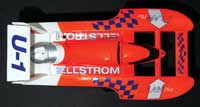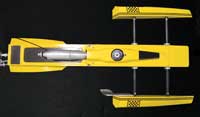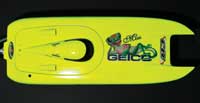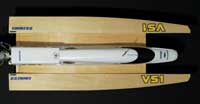Which is Best for You?

Whether you’re a new racer or a seasoned veteran, selecting the right hull for your driving style is important. It’s also important to understand what body of water you might be running or racing on. Additionally, what if any local or regional RC boating activity might be in your area. All of these factors should be considered when looking into the type of RC boat you might want.
Let us start with the body of water you will be running on. Most racers like myself tend to stay away from free flowing or very large bodies of water, but with the proper hull, speed and power system one can run their boat quite confidently on large bodies of water. Large bodies of water can build large swells and upset the fun you could be having with your boat. The ideal body of water is one that is protected from winds as well as having a good area from which to launch and retrieve your boat safely. It is extremely important that when running your boat, swimmers and full-scale boats are not in the immediate running area.
RC boats come in a variety of sizes, power systems and hull styles. For this article, we will identify a few hull types.

HYDROPLANES
Hydroplanes come in both full body hulls as well as outrigger hulls. Here we will touch on the major differences between them.

FULL BODY HYDROPLANES
Racers call these sport or scale hydroplanes and just as the name implies, they are full bodied like full-size unlimited or limited hydroplanes. This type of boat rides on a cushion of air as well as compressing the water with its sponsons. One of the challenges with a full body hydro is keeping it from blowing over or crashing. As a full body hydroplane builds speed it also packs more air under the hull. The faster the boat goes, the easier the boat can blow over. One very important fact is that hydroplanes only turn well in one direction, typically clockwise in our RC hobby. Sport and scale hydroplanes look great as they dance across the water. If you like the look of a scale hydroplane and enjoy that “on-the-edge feeling” a full body hydroplane just might be for you.

OUTRIGGER HYDROPLANES
Outriggers have an open distance between the center body and the sponson. This hull type packs less air, allowing greater speeds with less chance of a blow over. Outrigger hydroplanes are purpose-built for RC racing and the fastest boats in the RC boat hobby. Some are capable of speeds well over 100mph, and in a heat racing situation turn like a slot car. An outrigger hydroplane is the pure bred of RC boat racing. Keep in mind as you decide what type of hull you want that although outrigger hydroplanes are the fastest boats in the RC boating hobby, they do not tolerate rough water well and can be finicky to tune. They also only turn well in one direction.

MONOPLANES (MONOHULLS)
Monoplanes are boats that have a single planing surface and are sometimes called “V” hulls or deep-V. A monoplane also compresses air as it runs, but spills it off the sides as it builds speed. More importantly however, is how the water releases or sheds off the bottom of the hull as it rides across the water. Most monoplanes have strakes that shear the water from the bottom of the boat as it operates. Strakes also create lift or a force that raises the boat from the water. The faster your mono goes the more you have to control the lift by adjusting and tuning the hardware on the back of the boat. Monoplanes turn quite well in both directions. They can also handle rougher water than air suspended hulls. If your body of water is somewhat larger and maybe gets rough from time to time, a monoplane is a good choice.


CATAMARANS
Most RC catamaran hulls are based on the looks of full-scale catamarans. Performance is no less spectacular as they too can reach great speeds. Cats, like hydros, are also air suspended hulls, but the main difference is the length of the sponsons. The sponsons on a cat run the full length of the boat. As the boat races across the water, air is trapped and passes under the center of the hull. The faster the boat goes the more air it packs. As we learned with hydros, the cat too is susceptible to blow overs, but will run in slightly rougher water than a hydro. Catamaran hulls turn very aggressively and do so quite well both right and left. Catamarans are a good choice for sport running and are also a great choice for racing in some of the offshore lasses around the country.

TUNNEL HULLS
Almost all tunnel hulls use an outboard motor to propel the boat. Tunnel boats are the sports cars of the boat world and can place as much as 4Gs on the driver as it turns. Our RC models also turn super fast and in a straight line are literally flying across the water. Learning to tune a RC tunnel hull to “balance” as it operates is very rewarding. Tunnel hulls turn well both left and right, but don’t operate well on rough water. RC tunnel hulls are easy to work on and maintain as there are no difficult hardware kits needed during the build or setup of the hull. If you like a simpler build and setup and are willing to sacrifice a little speed compared to a hydro, this is a great hull style to choose.
TO SUM IT UP
Hydroplanes: Although the fastest hull design, they are limited to smooth water and only turn well one direction.
Monoplanes: The typical mono is not as fast as a hydroplane, but can operate on rougher water better than other hull types and also turn quite well in either direction.
Catamarans: Scale looks and aggressive steering are trademarks of a well designed and tuned RC cat. This hull style turns well both right and left and can reach fantastic speeds.
Tunnel Hulls: The tunnel hull is simpler to build and setup with speeds that are slightly slower than the other hull types, but the feeling of flying the boat across the water is hard to deny.

WRAP UP
Selecting a hull style is largely based on what you like in the appearance of a boat. When deciding on a RC boat, take some time to see what model boating activity might be in your area. Also see if there is a local club and check out what hull styles they might be running. And remember, RC boating is best shared with friends!
Words by Mike Zaborowski
 RC Boat Magazine The World's Leading Radio Control Boating Magazine
RC Boat Magazine The World's Leading Radio Control Boating Magazine
